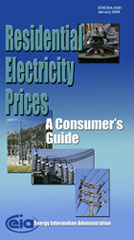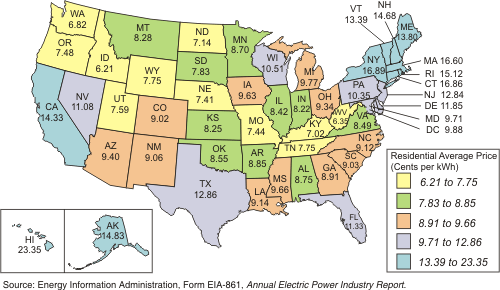|
Energy Information Administration Brochures |
||||
|---|---|---|---|---|---|
Brochure #:DOE/EIA-X061
Introduction Electricity is an essential part of modern life. In our homes we use it for lighting, running appliances and electronics, and for heating and cooling. Most consumers do not think much about their electricity until a power outage, or when they are “shocked” by a high utility bill. Fortunately in the United States, power outages are relatively infrequent and short in duration mainly because we have one of the most advanced, reliable, and well-maintained electricity generation, transmission and distribution systems in the world. Electricity bills, however, are frequent and unavoidable. The dollar amount charged each month is a function of the price per kilowatthour (kWh) and the amount of kilowatthours consumed; other add-ons to your bill include State and local taxes and costs for maintaining reliability. Further understanding of your monthly electric bill, and the history of retail electricity prices, begins with a discussion of the basics of how electricity is produced and delivered to the average residential customer. Where Does Your Electricity Come From?Electricity is delivered to you by the local utility through a network of existing transmission and distribution lines, often referred to as the “grid.” Transmission lines are the large, high-voltage power lines that move electricity from power plants to substations and are often supported by tall metal towers. Smaller, lower voltage distribution lines move power from substations and transformers, and are often seen along residential streets supported by wood poles. Most of the existing grid was built during a highly structured, highly regulated era designed to insure that everyone in the United States had reasonable access to electricity service. The utility customers, through fees authorized and regulated by State regulatory commissions, generally paid for developing and maintaining the grid. The utilities built power plants and connected the plants to the grid. Electricity generated at these plants is loaded onto the grid, where it is transmitted and distributed to you. Your usage is measured with a meter (Figure 1). Many local grids are interconnected for reliability and commercial purposes forming larger, more dependable networks to maximize coordination and planning. These networks extend throughout many States. The North American Electric Reliability Corporation (NERC) was established to ensure that the grid in the United States was reliable, adequate and secure. Some of its members have formed regional organizations with similar missions. These organizations are referred to as Independent System Operators (ISOs) and Regional Transmission Organizations (RTOs). They are part of a national standard design advocated by the Federal Energy Regulatory Commission (FERC). Some have members who connect to lines in Canada or Mexico. Most, depending on the location and the utility, are indirectly connected to dozens and often hundreds of power plants. The utility, distribution company or retail service provider selling you power may be a not-for-profit municipal entity, an electric co-operative owned by its members, a private, for-profit company owned by stockholders (often called an investor-owned utility), or a power marketer. Some federally-owned authorities--including the Bonneville Power Administration and the Tennessee Valley Authority, among others--also buy, sell and distribute power. The origin of the electricity you consume may vary. Utilities may generate all the electricity they sell utilizing just the power plants they own. Utilities may also purchase some of their supply on the wholesale market from other utilities, power marketers, independent power producers, or from a market based on membership in a regional transmission reliability organization. Also some residential, industrial, commercial, and institutional users of electricity have the means to produce electricity for themselves and sell any excess back to their utility. In addition, there is some power consumed in the United States that is imported from Canada and Mexico. Figure 1. Power Generation, Transmission, and Distribution
Source: Energy Information Administration What Are the Types of Power Plants that Generate Electricity?Power plants can be grouped into the types of fuel or energy source they use to produce electricity. These include fossil fuels (coal, natural gas, or a refined oil product), nuclear energy, and renewable energy sources such as water (hydroelectric power), biomass, waste-to-energy, geothermal, wind, and solar energy, as well as alternative fuels. Figure 2 shows the relative share of electricity generation by fuel/energy type. One of the features of electricity is that your television and stereo, heating system, air conditioning system, appliances and light fixtures cannot tell the difference between the types of generation, location, or fuel sources. This makes all the electricity on the system usable by all those connected to the grid. Figure 2. U.S. Electric Power Industry Net Generation by Fuel Source, 2006
Source: Energy Information Administration, Electric Power Annual 2006, November 2007, Table ES1. What Determines the Price of Your Electricity?A major component of the price of your electricity is the cost and availability of fuel used for power generation and the transmission necessary to deliver the power to you, as well as construction costs of plants and the associated expense for operation and maintenance. Supply and demand for fuel and transmission, international events and changes in weather also affect the price of your electricity. In most areas, the cost to generate electricity fluctuates daily and monthly. These fluctuations are a response to changes in demand for electricity. Daily demand for electricity is usually highest in the afternoon and early evening (on-peak). Seasonal peaks reflect regional weather and climatic conditions, with the highest occurring in the summer when air-conditioning use is greatest. Power plants tend to operate in two basic modes: base-load and peaking load. Base-load power plants are most effcient generating electricity at an even, consistent level, around the clock, and generally include nuclear, coal-fired, geothermal and waste-to-energy plants. Some plants may sit as a “spinning reserve” during off-peak or on-peak periods. Peaking plants are turned on or “dispatched” as demand increases above the normal base load or demand. Peaking plants are expensive to operate, often fueled by refined oil products, or natural gas, and have a fuel cost per kWh higher than a baseload plant. Hydropower plants can operate in base and/or peaking mode. A relatively small amount of electricity is generated from “pumped storage” plants. These economically effcient plants pump water from a river or reservoir up into reservoirs located above hydroelectric turbines. Additionally, some high-deliverability salt-dome natural gas storage facilities support power plants using natural gas providing an extremely flexible supply of power. Wind and solar power plants are referred to as intermittent resources. They may supply power during peak and off-peak periods depending on the availability of their energy source. Most investor-owned utilities are monitored and regulated by State Public Utility Commissions (PUC) and the FERC. The breadth and scope of regulation varies by State. Many States have “restructured,” but only some have embraced fully the deregulation of retail prices and the introduction of competition, which allows residential retail choice. Interest in restructuring has been declining. Retail choice availability varies by State. (Check with your State PUC or local utility for more information regarding retail choice availability.) Figure 3. Average Retail Price of Electricity Sold by U.S. Electric Power Industry, 1960-2006
Source: Energy Information Administration, Annual Energy Review 2007, Table 8.10. Average Electricity Prices in the United StatesThe 2006 price of residential electricity in the United States is 10.4 cents per kWh. There have been fluctuations in prices due to the oil shocks of the 1970s and the move towards greater conservation in the 1980s (Figure 3). Residential utility customer rates generally reflect the utility’s cost to produce or purchase power, plus associated transmission fees, ancillary services to increase reliability, and other costs incurred by the utility, plus a State-approved and regulated rate-of-return on the assets it owns. Most residential customers’ rates fluctuate on a seasonal basis, as overall demand increases and decreases, mainly in response to weather and climate conditions. Price differences by State are often related to the cost and availability of the fuels used to generate, as well as the existence of retail competition (Figure 4). Figure 4. U.S. Electric Industry Residential Average Retail Price of Electricity by State, 2006 (Cents per kWh)
Your Electricity Consumption Primarily Determines Your Total BillYour total bill for the month, before taxes and other add-ons, is the price per kilowatthour multiplied by the number of kilowatthours you have consumed over the month. The typical residence has numerous electricity consuming appliances and devices. Figure 5 shows residential electricity consumption by types of uses for electricity. Figure 5. U.S. Residential Electricity Consumption, 2006
What Can Residential Customers Do to Reduce Electricity Bills?There are several steps that you can take to reduce your electric bill. Conservation and increased effciency are popular methods. You can reduce your usage by turning off lights and appliances when they are not being used and add additional weather insulation to doors and windows if necessary. These are among the easiest and least-cost methods of reducing your electric bill. You may also want to buy more energy effcient lights and appliances. Some utilities offer demand management programs to encourage major electricity uses off-peak, including “time-of-use” rates, which are higher during peak demand periods and lower during off-peak times. Some utilities may allow you to average your annual bill over 12 months to lessen the shock of seasonally high bills. Check with your local utility to find out about the programs they have to help you reduce your monthly bill. In addition, consumers in some States have the option to choose the company selling them their electricity, which could result in lower prices. If you have that option, check the websites of your State PUC and your utility for the names of retail service providers or power marketers active in your area. For More Information …. EIA’s Electric Power Industry Overview NEIC’s Energy Kids Page NARUC – State Commissions’ Links Page DOE Office of Energy Effciency and Renewable Energy Consumer Info Page Status of Electricity Restructuring by State State Electricity Profiles Low Income Home Energy Assistance Program (LIHEAP)
| |||||





